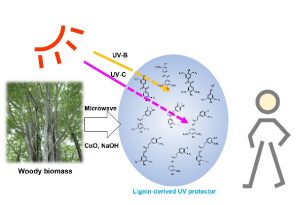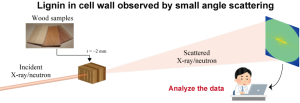2021 Activity Report for Mission 2:
Advanced Development of Science and Technology towards a Solar Energy Society
Updated: 2022/06/01
Research 1: Development of biological and synthetic catalysts for biorefinery
Principal Investigator (PI): Takashi Watanabe (RISH, Kyoto University)
Research collaborators: Yuki Tokunaga, Hiroshi Okano, Kaori Saito, Hiroshi Nishimura (RISH, Kyoto University), Takashi Nagata, Keiko Kondo, Masato Katahira (IAE, Kyoto University), Shunichi Irie (School of Env. Sci., Shiga Pref. Univ.)
For highly efficient lignin degradation, which is the key for lignocellulosic biomass conversion, we performed structure-function analysis of lytic polysaccharide monooxygenase (LPMO), which oxidatively depolymerizes cellulose. We expressed LPMO from the selective white rot fungus Ceriporiopsis subvermispora in yeast, analyzed its X-ray crystal structure, and analyzed its synergistic effects with cellulase. In addition, to analyze whether lignin functions as an electron donor for LPMO in cellulose degradation, we reacted LPMO with cellulose in the presence and absence of artificial lignin and milled wood lignin and analyzed the degradation behavior of cellulose and lignin. We also expressed a laccase mutant bearing lignin-binding peptides at the N- or C-terminus from the white rot fungus Trametes versicolor and analyzed its ligninolytic properties. We published a paper on microwave reactions producing UV-A and UV-B absorbing lignin-derived monomers and oligomers from woody biomass.
Strucructural modeling of cellohexose-binding LPMO from C. subvermispora (left)1, and production of UV absorvers from woody biomass by microwave reaction (rignt) 2.
Publications, etc.
- T Huyen Nguyen, Kiko Kondo, Yusei Yagi, Yu Iseki, Nagi Okuoka, Takashi Watanabe, Bunzo Mikami, Takashi Nagata and Masato Katahira, Functional and structural characterizations of lytic polysaccharide monooxygenase, which cooperates synergistically with cellulases, from Ceriporiopsis subvermispora, ACS Sustainable Chem. Eng., in press (2022).
DOI: https://doi.org/10.1021/acssuschemeng.1c06810
- Mikame, Yasunori Ohashi, Yoshiyuki Naito, Hiroshi Nishimura, Masato Katahira, Satoshi Sugawara, Kenzo Koike, Takashi Watanabe, Natural organic ultraviolet absorbers from lignin, ACS Sustainable Chemistry & Engineering, in press (2021).
DOI: https://pubs.acs.org/doi/abs/10.1021/acssuschemeng.1c05415.
Three related conference presentations (3 domestic presentations)
Research 2: R&D of Microwave Heating Applicators for Chemical Reaction
Principal Investigator (PI): Tomohiko Mitani (RISH, Kyoto University)
Research collaborators: Takero Toyonaga, Kento Suzuki, Baku Takahara, Naoki Shinohara (RISH, Kyoto University)
Microwave heating applicators for chemical processing were studied. A microwave heating system utilizing electromagnetic coupling for multiple samples was designed via 3D electromagnetic simulation, by adding resonators in one dimension. Feasibility studies on two new types of microwave heating systems utilizing orbital angular momentum modes and 0th-order resonators were conducted for uniform heating. In addition, a feasibility study on high-resolution microwave heating for hydrogels was conducted by utilizing standing waves in waveguides.
Publications, etc.
Six conference presentations (2 international and 4 domestic presentations)
Research 3: Structural analysis of lignin in wood cell wall
Principal Investigator (PI): Tomoya Imai (RISH, Kyoto University)
Research collaborators: Yoshiki Horikawa (Tokyo University of Agriculture and Technology), Yuki Tobimatsu, Soichi Tanaka (RISH, Kyoto University), Yoko Okahisa (Kyoto Institute of Technology), Keisuke Kojiro (Kyoto Prefectural University)
Lignin, one of the major components of the plant cell wall, is matrix substance that fills the space between crystalline cellulose microfibrils. Its amorphous nature makes it difficult to isolate lignin with its native morphology unchanged, and consequently, our understanding of lignin structure in the plant cell wall is yet to be further clarified. Given that lignin structure or distribution in the plant cell wall is closely linked to the physical properties of the cell wall, structural analysis of the lignin in the cell wall is very important for wood utilization. To this end, we analyzed wood cell walls with small-angle X-ray scattering (SAXS) and putatively concluded that SAXS is able to visualize lignin distribution in the wood cell wall.
Publications, etc.
One presentation in domestic scientific meetings
One paper was submitted and is under the review
Research 4: Study on functionalization of nitrogen doped carbonized Sasa
Principal Investigator (PI): Toshimitsu Hata (RISH, Kyoto University)
Research collaborator(s): Sensho Honma (HFPRI, Hokkaido Research Organization)
There is an urgent need for the development of CO2 storage materials and environmentally friendly energy devices related to global warming countermeasures. We focused on the nanopores of carbonized Sasa and investigated their carbon dioxide adsorption properties in order to produce useful materials from unused biomass to solve the global warming problem. The 350°C heat-treated product was placed in a crucible together with an aqueous potassium hydroxide solution and subjected to activation at 600°C for 1 hour. After cooling, the treated material was rinsed, dried, and weighed, and the weight loss rate due to activation (activation yield) was calculated. The resulting activated material was subjected to elemental analysis. Despite the weight loss of the sample due to chemical activation, it was possible to retain several percent nitrogen content. CO2 adsorption of 71.9 cc/g for leaves and 68.5 cc/g for culms was obtained at 0°C. This is comparable to the values obtained by gas adsorption in wood. The adsorption was higher in the leaf part of the Sasa plant than in the culm part, because the leaf part contains more nitrogen than the culm part.
Mission 2 –related studies (Presentations at the Mission 2 Symposium)
14 presentations were made at the Mission 2 symposium on November 2, 2021 as shown below.
- Study on simultaneous wireless information and power transfer by orbital angular momentum modes
- Simultaneous wireless information and high-power transfer system
- Production of antiviral materials from Japanese cedar wood powders by microwave solvolysis
- Development of wireless power transfer rectenna for wearable devices
- Microwave power transfer to drones
- Microstructural analysis of non-olfactory sensilla on underground termites Coptotermes spp.
- Study on high-frequency multielement antenna and its simple control for wireless power transfer
- Development of versatile antennas
- Synthesis of a stable isotope-labeled DHP for interaction analysis among lignin biomass degrading enzymes
- Theoretical study on Beltrami fields in microwave frequency bands
- Study on simultaneous heating of multiple samples by electromagnetic coupling-type microwave heating systems
- Development base of material modification techniques using sugar chain degrading enzymes for gum arabic
- Wireless power transfer by a 1/2 frequency retrodirective system
- Study on high-power rectifying circuits for wireless power transfer





